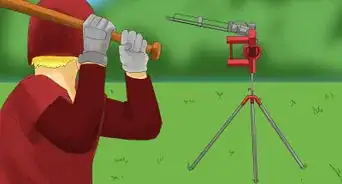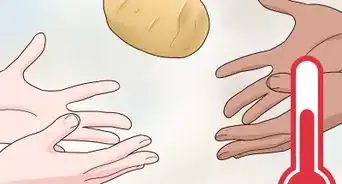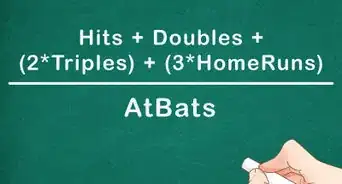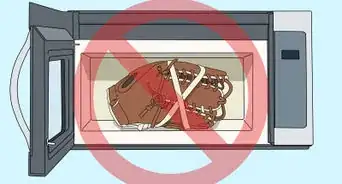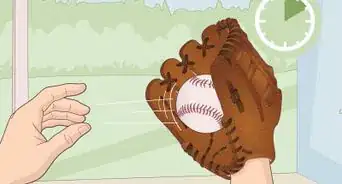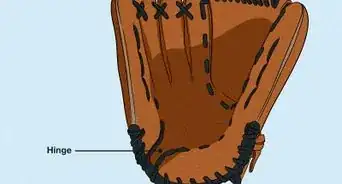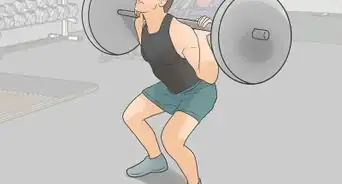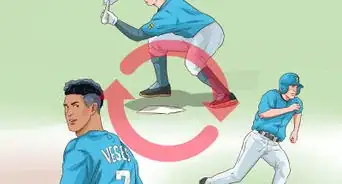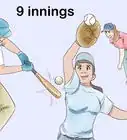This article was co-authored by Isaac Hess. Isaac Hess is a Baseball Coach, Instructor, and the Founder of MADE Baseball Development and Champion Mindset Training Program, a baseball training program based in Los Angeles, California. Isaac has over 14 years of experience coaching baseball and specializes in private lessons and tournaments. He has played baseball for both professional and collegiate leagues including Washington State University and the University of Arizona. Isaac was ranked as one of Baseball America's top 10 prospects for 2007 and 2008. He earned a BS in Regional Development from the University of Arizona in 2007.
This article has been viewed 651,341 times.
Once you've perfected your fastball, learn how to throw a curveball to improve your pitching skills. A well-thrown curveball looks like a fastball, but it spins in the opposite direction, causing it to "break" in a different direction before reaching the hitter. With a little luck, the hitter will swing early and miss the ball. To master this skill, you'll have to perfect your basic curveball, the straight curveball, and the knuckle curveball.
Steps
Throwing a Basic Curveball
-
1Grip the ball between your thumb and middle finger. Place your middle finger along the bottom seam of the baseball and your thumb along the back seam.[1] Leave your index finger off the ball. Instead of using it to grip the ball, you'll be using it to point at where you want the ball to go.[2]
- Hold the baseball such that the curves of the seams are close to your palm, with one on top and one on the bottom of your palm.
- For right-handed people, place your middle finger on the right seam on top, and your thumb on the left seam on bottom. Lefties should do the opposite.
-
2Keep your grip hidden. If the hitter knows you're about to throw a curveball, they'll be prepared for the change in speed and drop. It's important to hide your pitch until you wind up to throw it. Make sure your glove is covering your hand gripping the ball, so no one on the other team will be able to see that you're gripping for a curveball.[3]
- The basic curveball grip is easy for experienced hitters to spot even during the windup. Practice hiding your grip so your curveballs are harder to read.
Advertisement -
3Wind up and throw the pitch. Place your dominant foot on the rubber. Lift your opposite knee and rotate your hips forward as you throw the ball. Your elbow should be level with or above your arm, and bent at a 90-degree angle. Complete the first part of your curveball pitch as you would a fastball.
- A basic, four seam fastball will have your middle and pointer fingers on top of the ball on the seam that runs left and right across the ball when the ball is facing you. Your thumb should be directly on the smooth leather of the bottom of the ball, in between the seams.[4]
-
4Snap the release. Keep your palm facing inward towards your body, and release the ball as your arm extends and you step forward with the opposite foot. As your arm comes down from the throw, it should be headed toward the opposite hip.[5]
- Snap quickly from top to bottom, rather than moving your hand in an arc across your body.
- When you release the ball, rotate your thumb up and your middle finger down, as though you were going to snap your thumb and middle finger together. The ball will move in the direction your middle finger is pointing.
-
5Practice. Master a basic curveball before you move on to more complicated forms. Remember, the spinning action of the throw is achieved by gripping the ball without pressure from the index finger and snapping as the ball is released. Keep this movement in mind as you throw.[6]
Pitching a Straight Curveball
-
1Grip the ball between your thumb, forefinger, and middle finger. This is the classic curveball grip. Grip the ball with the bottom seam between your index and middle fingers, and place your thumb along the back seam. Hold the baseball such that the curves of the seams are close to your palm, with one on top front and one on bottom rear of the ball.[7]
- The "front" of the ball refers to the part that will be traveling away from you when thrown, while "rear" refers to the part of the ball facing you after the ball is thrown.
- For right-handed people, place your middle finger on the right seam on top, and your thumb on the left seam on bottom. Lefties should do the opposite.
- Use your index finger to point at the target. As with the basic curve, you should be using your index finger to point at where you wish to throw the ball. This time, though, it'll also be steadying your middle finger.
-
2Keep your hand position hidden. Same as with most pitches, you'll want to make sure your grip isn't visible to the other team by hiding it behind your glove until you wind up to throw the pitch. Otherwise, the hitter will be warned that you're about to throw a curveball, and you aren't likely to get the results you want.[8]
- If you have difficulty hiding your pitch before the wind up, you may want to position your ball as deeply in your mitt as possible before taking your grip on the ball.
-
3Wind up and throw. Put dominant foot on the rubber, in a parallel position. Lift your opposite knee and rotate your hips forward as you throw the ball. Your elbow should be level with or above your arm, and bent at a 90-degree angle. This windup is exactly the same as that you'd use when throwing a fastball.
-
4Release the ball with a snap. Keep your palm facing inward toward your body, and release the ball as you step forward with the opposite foot. As your arm comes down from the throw, snap it toward the opposite hip.
- As you release the ball, rotate your thumb upward and your middle finger downward, as though you were snapping your thumb and middle finger together.[9]
-
5Try modifying your grip. If you slightly change the positioning of your fingers, you can change the way the ball breaks, confusing the hitter even more. Regular curve balls are known as 11-5 throws because the ball breaks in the angle formed by the 11 and 5 numbers on a clock. Try these variations to make your throw break differently:
- A 12-6 curve ball will break downward more sharply. Place your index and middle fingers between the seams, and your thumb on the bottom of the ball. Do an abbreviated snap as you throw, or release the ball as your hand passes your head instead of following the arm motion all the way through. To account for the sharp break, throw a 12-6 a bit higher than you would a normal curve ball.
- A 10-4 curve ball will start up and close to the hitter, then break low and away. Start your grip as you would for a traditional curve ball then slide your index and middle fingers downward a bit, toward your thumb. Place the majority of the pressure on your middle finger, and turn your wrist outward from your body as you throw.
Throwing a Knuckle Curveball
-
1Grip the ball. The knuckle curveball is similar to other grips, but the variable this time will be your index finger. Grip the ball with your middle finger along the bottom seam, and your thumb along the back seam. Hold the baseball such that the curves of the seams are close to your palm, with one on top and one on the bottom of your palm. Bend your index finger inward before laying it on the ball so that your nail and top knuckle are resting on the ball and your middle knuckle is pointing at the target.
- For right-handed people, place your middle finger on the right seam on top, and your thumb on the left seam on bottom. Lefties should do the opposite.
- Getting comfortable with a knuckle curve ball grip can take practice. Acclimate yourself to how it feels by practicing the grip, without throwing, when you have downtime.
- This kind of curveball is considered more advanced than other kinds. Don't be discouraged if it takes some time to master.[10]
-
2Use your index knuckle to point at your target. As with the straight curve, your index finger will be both pointing to the target and steadying your middle finger, but has the added benefit of adding more torque through the bending of your knuckle.
-
3Keep your grip hidden in your baseball glove. This is extra important with a knuckle curve ball, since your finger placement will make it obvious at a glance. Make sure the ball is deep in your glove before taking hold of it with the knuckle curveball grip.[11]
-
4Wind up and throw. Your dominant foot should be on the rubber, in a parallel position. Lift your opposite knee and rotate your hips forward as you throw the ball. Your elbow should be level with or above your arm, and bent at a 90-degree angle, same as a normal fastball pitch.[12]
-
5Snap the release. Keep your palm facing inward to your body, and release the ball as you step forward with the opposite foot. The ball should be out of your hand shortly after it passes your head. As your arm comes down from the throw, snap it toward the opposite hip. Twist your thumb upward and your middle finger downward to put a spin on the ball.
Expert Q&A
Did you know you can get expert answers for this article?
Unlock expert answers by supporting wikiHow
-
QuestionHow do you throw a curveball for a 12 year old?
 Isaac HessIsaac Hess is a Baseball Coach, Instructor, and the Founder of MADE Baseball Development and Champion Mindset Training Program, a baseball training program based in Los Angeles, California. Isaac has over 14 years of experience coaching baseball and specializes in private lessons and tournaments. He has played baseball for both professional and collegiate leagues including Washington State University and the University of Arizona. Isaac was ranked as one of Baseball America's top 10 prospects for 2007 and 2008. He earned a BS in Regional Development from the University of Arizona in 2007.
Isaac HessIsaac Hess is a Baseball Coach, Instructor, and the Founder of MADE Baseball Development and Champion Mindset Training Program, a baseball training program based in Los Angeles, California. Isaac has over 14 years of experience coaching baseball and specializes in private lessons and tournaments. He has played baseball for both professional and collegiate leagues including Washington State University and the University of Arizona. Isaac was ranked as one of Baseball America's top 10 prospects for 2007 and 2008. He earned a BS in Regional Development from the University of Arizona in 2007.
Baseball Coach & Instructor
-
QuestionWhat is the best way to throw a curveball?
 Isaac HessIsaac Hess is a Baseball Coach, Instructor, and the Founder of MADE Baseball Development and Champion Mindset Training Program, a baseball training program based in Los Angeles, California. Isaac has over 14 years of experience coaching baseball and specializes in private lessons and tournaments. He has played baseball for both professional and collegiate leagues including Washington State University and the University of Arizona. Isaac was ranked as one of Baseball America's top 10 prospects for 2007 and 2008. He earned a BS in Regional Development from the University of Arizona in 2007.
Isaac HessIsaac Hess is a Baseball Coach, Instructor, and the Founder of MADE Baseball Development and Champion Mindset Training Program, a baseball training program based in Los Angeles, California. Isaac has over 14 years of experience coaching baseball and specializes in private lessons and tournaments. He has played baseball for both professional and collegiate leagues including Washington State University and the University of Arizona. Isaac was ranked as one of Baseball America's top 10 prospects for 2007 and 2008. He earned a BS in Regional Development from the University of Arizona in 2007.
Baseball Coach & Instructor Grip the ball in a certain way on the side of the horseshoe. There is no one right way there; you can have multiple grips. The back of your hand is going to face out. So if I'm a lefty, it's going to face to the left when I'm at release, and the palm is going to be right. It's going to be as if I'm pulling down and shaking cans or pulling down a light, if there's a string that pulls a light lamp.
Grip the ball in a certain way on the side of the horseshoe. There is no one right way there; you can have multiple grips. The back of your hand is going to face out. So if I'm a lefty, it's going to face to the left when I'm at release, and the palm is going to be right. It's going to be as if I'm pulling down and shaking cans or pulling down a light, if there's a string that pulls a light lamp. -
QuestionDo I need to throw a curveball fast?
 Community AnswerNo, curveballs are supposed to have movement. Usually it is the movement that confuses hitters, not the speed (which is why they are called off-speed pitches).
Community AnswerNo, curveballs are supposed to have movement. Usually it is the movement that confuses hitters, not the speed (which is why they are called off-speed pitches).
Warnings
- Throwing a curve ball for a long period can hurt your arm. A 12-6 curve puts a lot of stress on the UCL.⧼thumbs_response⧽
- Do not twist your arm to throw a curve. You can easily do harm to your humerus bone throwing in this fashion.⧼thumbs_response⧽
- Do not start throwing a curve ball until you're at least at the age of 15 or older. Practicing this pitch at too young an age could harm your muscular development.⧼thumbs_response⧽
- Never twist your wrist when throwing a curveball or a slider. When releasing a curveball, rotate your arm downward as if you were executing a karate chop or shaking someone's hand. Bring your throwing arm to opposite side hip (if you're a righty that's to the left hip, and vice versa for a lefty).⧼thumbs_response⧽
References
- ↑ Isaac Hess. Baseball Coach & Instructor. Expert Interview. 20 March 2020.
- ↑ http://www.thecompletepitcher.com/how_to_throw_curveball.htm
- ↑ http://baseball.isport.com/baseball-guides/how-to-throw-a-curveball-in-baseball
- ↑ http://www.thecompletepitcher.com/pitching_grips.htm
- ↑ Isaac Hess. Baseball Coach & Instructor. Expert Interview. 20 March 2020.
- ↑ http://baseball.isport.com/baseball-guides/how-to-throw-a-curveball-in-baseball
- ↑ http://www.thecompletepitcher.com/how_to_throw_curveball.htm
- ↑ http://baseball.isport.com/baseball-guides/how-to-throw-a-curveball-in-baseball
- ↑ http://www.thecompletepitcher.com/how_to_throw_curveball.htm
About This Article
To throw a traditional curveball, grip the ball with your middle finger resting against the bottom seam of the ball where it curves back into a circular pattern. You can also grip the ball with your index and middle finger resting parallel to the seams at their narrowest point if you find that more comfortable. Use your normal pitching mechanics and do not change anything about the size of your kick or the path of your arm to disguise the pitch and keep batters from identifying the pitch ahead of time. As you’re delivering your throwing arm forward, instead of releasing the ball with your index and middle fingers behind the ball, turn your wrist at a slight angle so that your index and middle finger are almost on top of the ball. Follow through in the same way you normally would for any other pitch. If you find yourself constantly throwing the ball out too high, try shortening your forward stride by 2-4 inches (5-10 cm) to force your arm to take a sharper downward path as you release the ball. If you keep throwing your curveballs in the dirt, aim to release the ball fractions of a second faster than you normally would with a fastball. If you can’t seem to get a good snap to the ball, practice playing toss with the curveball grip and wrist path to get used to it. If you want to learn how to throw a knuckle curveball, keep reading the article!

